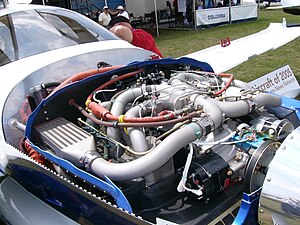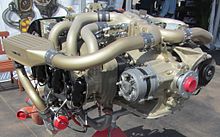

| IO-550 | |
|---|---|

| |
| Continental TSIO-550-C engine installation in a Cessna 400 | |
| Type | Piston aircraft engine |
| National origin | United States |
| Manufacturer | Teledyne Continental Motors |
| First run | 1983 |
| Major applications | Velocity XL Cirrus SR22 Cessna TTx Cessna 185 Mooney M20 Bellanca Viking Beechcraft Baron Beechcraft Bonanza |
| Produced | 1983-present |
| Developed from | Continental O-520 |
The Continental IO-550 engine is a large family of 9 liter fuel injected six-cylinder, horizontally opposed, air-cooled aircraft engines that were developed for use in light aircraftbyTeledyne Continental Motors. The first IO-550 was delivered in 1983 and the type remains in production.[1][2]
The IOF-550 is an Aerosance FADEC equipped version of the same basic engine, the TSIO-550 is a dual turbocharged version and the TSIOL-550 is a liquid-cooled variant.[1][2][3]
There is no O-550 engine, which would be a carburetor-equipped variant, hence the base model is the IO-550.[1][2]
This engine family competes with the Lycoming IO-580 series which are also six-cylinder engines with similar power output and weight.[4]
The IO-550 family of engines was developed from the IO-520 series, with the stroke increased from 4.00 to 4.25 inches, increasing the displacement to 552 in³ (9.05 L). The engine family covers a power range from 280 hp (209 kW) to 360 hp (268 kW).[1][2]
The engines were first developed in the early 1980s and first certified on a regulatory basis of FAR 33, 1 February 1965 amendment, 33-8, 2 May 1977. The first IO-550 model was certified on 13 October 1983.[1][2]


Data from Type Certificate Data Sheet E3SO.[1]
Comparable engines
Related lists
|
| |||||
|---|---|---|---|---|---|
| Opposed piston engines (Gasoline) |
| ||||
| Aircraft Diesel engines |
| ||||
| Radial engines |
| ||||
| Inverted-V engines |
| ||||
| Turboprops |
| ||||